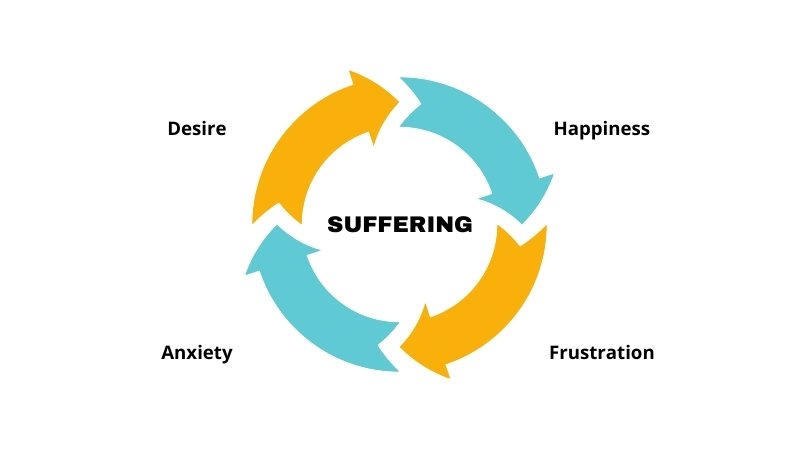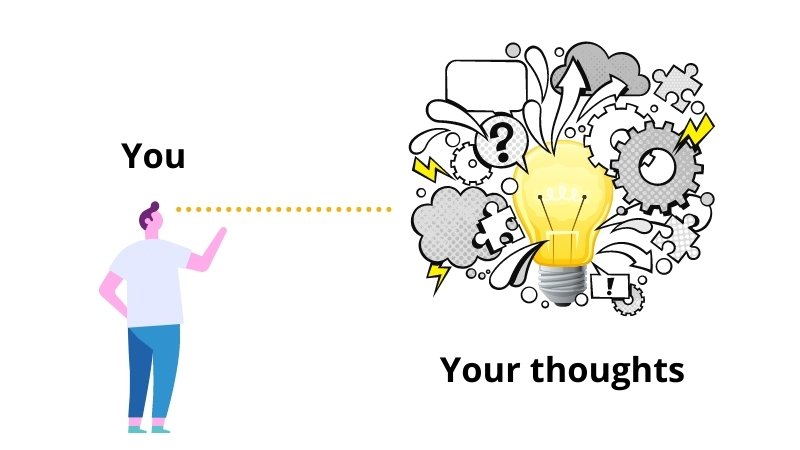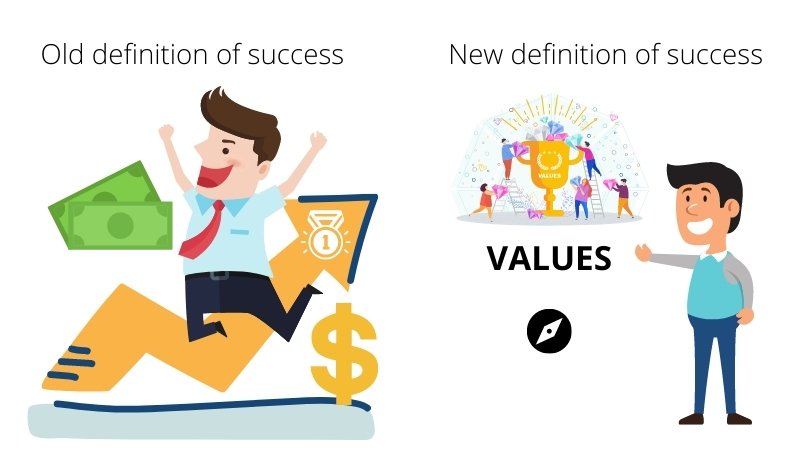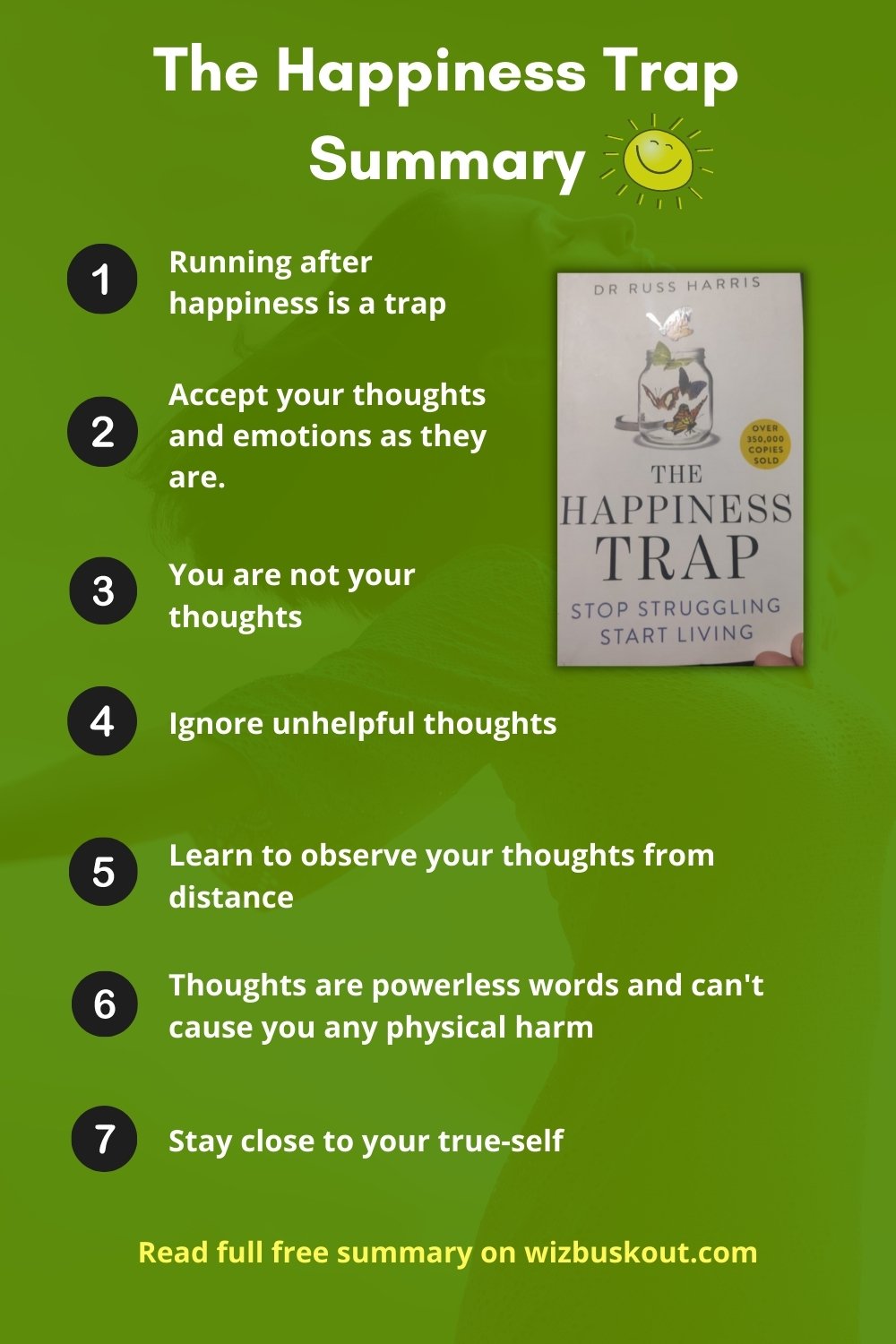Quick Summary: The Happiness Trap by Dr. Russ Harris explains why chasing after happiness is a trap that pushes you into the vicious cycle of suffering. And how you can use Acceptance And Commitment Therapy (ACT) to live a meaningful life guided by values.
The Happiness Trap Summary (PDF)
Want to know the secret to true happiness?
Do you feel sad when negative thoughts fill your mind?
Want to know why most people keep struggling and never become truly happy in their lives?
Well, in this book summary, you’ll learn answers to all these questions.
So without further ado, let’s dive right in.
Best Tools for Bibliophiles
- Listen to your Favorite Books on The Go: Try Audible and Get Up To 2 Free Audiobooks | Get 3 Free Audiobooks
- Read over 2 million e-books on any device: Sign up for 30 days free trial of Kindle Unlimited and read your favorite titles.
- Get free 2-day shipping of your favorite books and stream premium TV shows on Amazon Prime: Sign up for 30 days free trial of Amazon Prime.
- I use Notion to take reading notes, plan everything, and run all my businesses. (Notion is my Second Brain 🤯): Get Notion for free for personal use (paid for teams/businesses)
Lesson #1: Most people have wrong ideas about happiness
The author says that most self-help books work on the idea that you should be happy all the time.
Unfortunately, after reading this book, I realized that happiness isn’t normal.
Happiness is an excited state where you have many happy feelings and thoughts.
But they are not perpetual.
Sooner or later, bad thoughts vanish or are replaced. And happiness wears off.
In fact, running after happiness can be troublesome.
The more you run after it, the harder it gets to be happy.
Let me explain:
When you try to be happy, you want more optimistic thoughts to fill your mind.
By nature, our minds are not designed to be happy all the time.
The author says that due to evolution, our minds are conditioned to protect us from dangers and therefore continuously check the environment for any potential dangers.
Due to this, most thoughts are often related to potential troubles.
A few examples are:
“What if I fail?”
“What if I’m wrong?”
“I’m not good enough.”
Unfortunately, such thoughts pop up in our minds when we do something challenging or meaningful.
And get in our way.
So most people think that if they get rid of those negative thoughts, they will be happy.
They try hard to suppress such thoughts. They try to bury them deep down within themselves.
And guess what happens?
They sometimes stop for a moment. Then ultimately, they come back.
Here is what you should know:
Happiness is not normal.
It’s a state that gives you pleasant feelings.
But always remember that those happy feelings may go.
You don’t have to have them always in your head.
If they are present, sure cheer up.
And if negative thoughts replace them, don’t get worried.
Remember, your thoughts are not permanent.
They will be gone soon. And will be replaced by the other ones.
Lesson #2: The more you chase happiness, the more sadness you invite
As the name says, The Happiness Trap is when you chase after happiness.
Chasing after happiness results in anxiety.
When you don’t get happy, you feel sad.
The sadder you feel, the more the negative thoughts in your mind start controlling you.
See? It’s a vicious cycle.

Which can only be broken by giving up.
Yes, you may have heard motivational phrases like ‘Never give up!’.
But in this case, the sooner you give up, the better.
The only way to become happy, according to the author, is to stop running after happy feelings.
Okay, so why do people chase happiness even when it’s bad?
The short answer: Conditioning.
People have been conditioned to think that if you are not happy, there is something wrong with you.
They say: You are not normal if you are not happy.
Or in other words, every person believes that he must be happy.
Lesson #3: You can’t control your thoughts and emotions
This is a big lesson.
If you pay attention to your thoughts or are mindful enough, you will realize that you can’t control your thoughts no matter how hard you try.
Please don’t believe me. Try it yourself.
Do this:
Don’t think about a pink elephant flying in the air.
What did you imagine?
Probably, you imagined exactly what I told you not to.
Didn’t some thoughts related to the pink elephant come to your mind? I bet they did.
No matter who it is, human psychology works the same.
See now?
You can’t control your thoughts every time.
But they can control you if you are not mindful enough.
When people try to become happy, they usually try to control their thoughts and emotions.
Which you now know is almost impossible. (Trap)
You may control your thoughts for a moment.
But they will come back sooner or later.
Please note that when we talk about controlling our thoughts, we usually talk about controlling negative thoughts.
Nobody wants to control positive or uplifting thoughts, right? We want more of them.
Again, wanting more of them is a trap.
Here is the best part:
Your thoughts can’t physically attack you. They can control you through your mind, though.
But thoughts themselves are powerless.
After all, they are just words.
Have this type of attitude. This way, you’re more likely to be happy. (More on this later…)
Although words have power, they can’t possibly kill you.
It is both ways. You can’t completely destroy them either.
So why not sign a peace treaty?
Sadly, they won’t listen to you. You have to have a big heart.
You have one, right?
Let’s delve deeper…
Lesson #4: Welcome your inner demons, don’t fight them.
The author calls the troubling, negative thoughts as inner demons.
They may look scary, but they can’t harm you.
They only harm you when you take them too seriously.
The moment you see your inner demons as powerless, they lose most of their power.
Why do most people struggle with negative thoughts?
The answer is:
They don’t accept.
Allow me to explain.
As soon as people notice negative thoughts lurking inside their minds, they try to get rid of them.
They strongly desire that those troublesome thoughts vanish.
They don’t want to accept the fact that negative thoughts exist. They remember the time when they were happy.
They start feeling guilty.
Eventually, they enter into a vicious cycle of suffering.
The harder they try to eliminate those negative thoughts, the stronger their existence becomes.
They think it’s their fault to have such thoughts in their head.
Well, they are wrong.
It’s not their fault. It’s the thinking self’s fault. (More on this later…)
In short:
Not accepting your inner demons can have harmful consequences.
So first thing:
Accept that you are having negative thoughts when they appear.
Don’t start struggling when you notice them.
Logically speaking: Our thoughts are nothing more than just words.
The only difference is:
We have almost no control over them.
Accept this fact. This will make things easier.
Remember, this is a crucial step. If you don’t stop struggling with them, you make things harder for yourself.
Accept your thoughts with an open heart – even if they are the bad ones.
Don’t judge your thoughts.
Accepting your thoughts doesn’t mean that you have to accept defeat.
Your thoughts can’t defeat you. But when you start a war with them, you get into trouble.
The author even says that you should thank your mind for producing thoughts.
Remember, thoughts are helpful in many cases.
They are problematic only when they create fear, hopelessness, low self-esteem, or anything else we don’t like or wish to have.
Lesson #5: Distance yourself from your thoughts

The author talks about cognitive fusion in this book.
We also discussed a similar concept in Rewire Your Anxious Brain Summary too.
The reason our brain produces anxiety and fear is:
We fuse reality with our thoughts.
In simple words:
We think that our thoughts represent reality.
Not all thoughts are real. Most thoughts are useless.
It’s such a wonder why do we even bother to heed them.
You don’t need to cognitively fuse with your thoughts to avoid unnecessary anxiety.
Not to mention, when you are anxious, you are not happy.
Again, you don’t have to be happy.
Remember, happiness is not a normal state. It’s an excited state.
That’s why we desire more of it.
The author recommends that you develop the skill of defusion.
So what does defusion mean?
Defusion is when you distance yourself from your thoughts.
When you cognitively defuse, you separate thoughts from your reality.
Now, what happens? You suddenly realize that your thoughts are no more than words.
Look at the very words you are reading right now.
Can they do anything to you physically? Hell no.
They are powerless, right?
So why and how do they create problems? Remember, you think they are real. That’s the problem.
Don’t do that.
Don’t take your thoughts too seriously.
If possible, laugh at them.
Pity them for the fact that how powerless they are. (Okay, that was too much.)
Lesson #6: Give some room to your thoughts
Yes, it’s hard to allow your negative thoughts to provide shelter.
But have a big heart.
Shelter them. Embrace them.
Don’t judge them too hard. They are thoughts, after all. Remember, they can’t physically harm you ever.
Notice how they behave.
You have to accept your thoughts.
ACT stands for Acceptance And Commitment Therapy.
This book focuses on that.
Notice the first word is Acceptance.
You can’t practice this therapy unless you learn to accept the components of your internal world.
Most self-help books suggest many tips and tricks that can help you get rid of negative thoughts in the short term.
So don’t force yourself to get rid of your negative feelings.
Instead, do the opposite.
Embrace them.
To be honest, you don’t have a choice.
Even if you try to turn against them, you can’t win.
You can suppress them.
But the more you suppress them, the stronger they become and bounce right back at you.
So give them some room. Embrace them.
And simply observe.
Watch how they affect you.
Lesson #7: Ignore the unhelpful thoughts
Now you know that your thoughts are no more than words.
You have accepted them.
You have embraced them and given them some room.
You are now observing them.
Here is what you need to do now:
Ignore those thoughts that don’t help you.
Is it that simple?
Of course, not. It will come with practice.
Don’t expect to be good at it in the beginning.
Even accepting all of your thoughts will be difficult at first. It’s pretty similar to learning any skill. You don’t just become a master right off the bat.
The question is:
How do you figure out which thoughts are helpful and which are not?
The author has told a fantastic way to do that:
“Does this help me live a life I want to live?”
If the answer is “yes,” then entertain that thought.
And if the answer is “no,” then why bother, right?
Every book you read or every content you consume is there to help you lead a meaningful life.
Anything that stops you from living a life you want to live should be eradicated.
You are not your thoughts. So whenever you find yourself having useless thoughts, accept them and ultimately ignore them.
As long as you keep taking them seriously, you waste your precious time, which could be used to do meaningful tasks.
Find out what you value the most.
Those are your values.
Your values must act as a compass guiding you in every phase of your life.
Try to make your actions harmonious with your values.
That’s a better way to a meaning-rich life.
Lesson #8: Your definition of success is wrong

This was a lightbulb moment for me.
Our definition of success is wrong.
What do we mean by success?
Usually, when we say a person has become successful, we mean that he has many achievements.
We think we are unsuccessful because we have not achieved anything significant in our life.
Or, to be more precise: if someone has gathered lots of power, wealth, status, love, etc., we call him successful.
Now think again:
Who told you this definition?
If you dig deeper, you will find out that these definitions of success are given to you by the people around you (society) or those who appear on social media or television (celebrities).
If you live your life by this definition, chances are you’ll always desire more.
You will want more money. You will desire more happiness.
Look, I’m not saying that you should not desire anything.
But when we are always craving for more, we start craving more happiness.
We start thinking that craving more happiness is normal.
You think, ‘Everybody is doing it, so why shouldn’t I?’
But look where it leads you:
Never-ending suffering.
Almost every self-help book these days confirms this idea that you should be happy. Otherwise, you have a problem.
I love this idea from the author. He has redefined success:
“If you are living your life by values, you are successful.”
Feeling relaxed?
Don’t you feel lighter now after hearing that definition?
As long as you are guided by what you truly value, you are hell more successful than people living a life that doesn’t mean anything to them.
Maybe they have lots of status and power.
But if they are not guided by values, they are not successful.
The idea is not to stop you from having achievements.
The idea is to prevent the vicious cycle of suffering. (Stopping the cycle for good is challenging as our desires never stop)
When you go by the old definition of success, you never become truly happy.
There is always something more you can achieve, which is good.
But it also comes at the risk of developing unrealistic standards like always trying to be happy.
Life is full of suffering.
And no human has ever been born who didn’t suffer or struggle in his life.
Happiness is not normal. Neither is suffering.
So expect both of them.
Set the right expectations about life.
When you ride a roller coaster, you know, you experience both highs and lows. Life is like that too.
You’ll be happy at times. Also, you will find times when you struggle.
Lesson #9: You are the sky who witnesses it all
This lesson is both from the book and spirituality.
Although the author says that the ACT doesn’t derive its ideas from spirituality or religion, we can still draw parallels.
The author shares an analogy that who we call ‘I’ is the observing self who sees everything but doesn’t interfere.
If you look at the thoughts, they are like demons who come out of nowhere.
On the other hand, we have our observing self, which sees all the demons but never judges them.
Our observing self is like the sky, watching the clouds as they come and go. It’s always there.
Spirituality also talks about this same idea.
Our true self is our observing self. It’s always there. It is perfect and limitless.
The closer we are to our true self, the better we can handle our thinking self, who is constantly producing thousands of thoughts (most of which are useless and create anxiety issues).
Remember, you are like the sky. The sky is always the same.
The only thing that changes is the weather.
Sometimes, it gets cloudy and stops the sunlight from reaching the earth.
While the other times, it is clear and sunny.
The point is:
The weather keeps changing.
Your true self is like a sky. It doesn’t change.
While your thinking self is like the weather, it keeps changing.
Just like the weather, you don’t have any control over it.
So let it be and stay close to your true self.
Your true self can’t be damaged. It doesn’t need any thought to exist.
It’s always watching like the sky.
Guide your life by your values.
Ignore the useless thoughts.
Don’t run after happiness just because everyone is doing it.
Never try to control your inner world. Let it be and embrace it.
It’s there to protect you anyway. Be thankful for your inner world.
Buy this book on Amazon: Paperback | Audiobook
The Happiness Trap Summary Takeaways
Here is a quick recap of all the lessons you learned in this summary:
- Stop running after happiness
- You are not your thoughts
- Distance yourself from your thoughts and observe them
- Thoughts are just powerless words as long as you don’t give them any value
- Ignore the unhelpful and toxic thoughts
- Stay close to your true-self
Best Tools for Bibliophiles
- Listen to your Favorite Books on The Go: Try Audible and Get Up To 2 Free Audiobooks | Get 3 Free Audiobooks
- Read over 2 million e-books on any device: Sign up for 30 days free trial of Kindle Unlimited and read your favorite titles.
- Get free 2-day shipping of your favorite books and stream premium TV shows on Amazon Prime: Sign up for 30 days free trial of Amazon Prime.
- I use Notion to take reading notes, plan everything, and run all my businesses. (Notion is my Second Brain 🤯): Get Notion for free for personal use (paid for teams/businesses)
The Happiness Trap Summary Infographic

The Happiness Trap Review
This book has taught me some great lessons about happiness.
I also realized how wrong I was when I thought about success.
The author’s definition of success resonated with me. I felt a sense of calm.
Most of the author’s techniques in this book are similar to meditation in spirituality.
The concepts like the observing self (the witness of our experiences) directly come from Hinduism scriptures. I don’t know much about the others, though.
The problem I noticed with this book is not uncommon: It has lots of repetition.
After reading half of the book, there was nothing much left to read. The author has tried his best to hammer the ACT concepts by repeating them repeatedly.
Maybe it’s for a reason.
I believe this book could be written more concisely. It didn’t need so many chapters.
The thing I liked about this book is how it separates itself from the other self-help books out there.
I’ve read lots of self-help books.
And almost all self-help books promote the idea that you should be happy. Otherwise, there is something wrong with you.
If you are an avid reader of non-fiction books, you will relate with me better here.
Overall, this book is an excellent read on happiness.
I recommend you read this book at least once.
Also, don’t forget to practice the concepts discussed.
Remember, ACT (Acceptance And Commitment Therapy) means ACTION.
If you don’t act based on the ideas that I shared with you from this book, you will remain in the same state.
So take some ACTION.
Buy this book on Amazon: Paperback | Audiobook
Other recommended summaries
Here are a few related summaries:
- Book Summary: Ikigai by Hector Garcia
- Book Summary: Be awesome Live Awesome by Himeesh Madaan
- Book Summary: The Power Of Intention by Dr Wayne Dyer
- Book Summary: Think Like A Monk by Jay Shetty
Now it’s your turn!
If you enjoyed reading this book summary, feel free to share it.
Now you tell me:
Do you believe the ACT can help you live a meaningful life?
Do you agree with the idea that the more we chase happiness, the sadder we become in the long run?
Let me know your thoughts in the comment section below.
Want to consume more insightful, power-packed content like this in the future?
Subscribe to the weekly email newsletter.
Subscribe to YouTube channel for animated video books.
Try Amazon’s Audible 30-days Free Trial and Get 2 Audiobooks for free.

